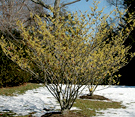Tips on winter gardening
Give more thought to your garden in winter, says Roddy Llewellyn who outlines his tips for plants which guarantee winter cheer


I know it's no coincidence that the majority of gardens open to the public close their gates with the approach of winter. As the nights draw in, temperatures drop, deciduous trees lose their garb, and a feeling of melancholy tends to pervade, along with a retreat towards the warmer indoors. The positive approach is to plan for visual appeal during the colder months to ensure that the garden remains an inviting place. Cancel your tickets for the West Indies, I say, and give more thought to your garden in winter.
Evergreen plants spring to mind as obvious ingredients for gardens which at this time of year are denuded, for the most part, of leaf and flower. I am devoted to topiary and the range of species that can be shaped with shears means that you need not lack variety in terms of leaf colour or texture. As well as trimmed yew and common box, look out for the holm oak, Quercus ilex, Phillyrea angustifolia (the 'false olive', very fashionable during Tudor times and now making a resurgence), and Portugal laurel, Prunus laurocerasus ? surely the most attractive of the laurels because of its shiny, not-too-large leaves of darkest green.
Other tamed plants, particularly box used as low hedging, or germander, Teuchrium fruticans, give invaluable structure to the garden in winter, defining the shapes of formal beds. These two plants, when combined to thread through each other in a knot garden, with the small gaps filled with different coloured gravels or marbles, give delight on a grey day.
Using edging plants of a more lax, but yet neat and rounded habit, is an alternative if stiff joints prevent genuflection. Suitable candidates in this category include Lavandula Imperial Gem, a neat lavender, similar in habit to the widely sold L. Hidcote, bearing prolific dark purple flowers when summer arrives. And some of the hebes are useful and informal low edgers, especially Hebe albicans (with grey-green foliage) or Red Edge (with blushing foliage in winter).
Climbing roses grown up deciduous trees always look messy, especially in winter, when their thorns unnervingly aim for the ear as you pass innocently by, resulting in your having to dash indoors, blood everywhere. Similarly prickly, but more decorative in winter (and not a climber), is Rubus cockburnianus, an ornamental blackberry whose young bare stems are covered in a brilliant white bloom. A run of it could be planted to make a fascinating, rather ghostly tall hedge in a wilder part of the garden; it also looks handsome in the company of deciduous shrubs with brilliantly coloured winter stems, such as the willow Salix alba vitellina (bright yellow canes) or the dogwood Cornus alba Westonbirt (glowing, deep red).
Although winter flowers tend to be on the small size, they more than compensate with their glorious scent, which is why their planting positions are their secret to success. There's no point in planting wintersweet Chimonanthus x praecox, for example, in a place that you don't pass by often. Oh, for a scented whiff as you struggle up the path laden with shopping! The same can be said for Christmas box (Sarcococca spp.), which makes an excellent bed-fellow with mahonias and hellebores as they all flower at the same time. Sarcococcas are small evergreens of neat habit, but S. humilis can romp away with the help of suckers.
In any garden where space allows, I'd create a separate, hedged-or fenced-in section devoted to winter-flowering plants. If that's not practicable, I'd bunch the winter-flowerers together, close to the house, although it is worth bearing in mind that the following aren't that exciting from April through to October.
Exquisite houses, the beauty of Nature, and how to get the most from your life, straight to your inbox.
My choice would certainly include witch hazels (Hamamelis mollis and its cultivars), with bright yellow or rusty-orange spidery blooms along dark, bare stems and Prunus x subhirtella Autumnalis, showered in pale pink-to-white flowers intermittently from mid-autumn well into spring. Another favourite is Viburnum x bodnantense Charles Lamont. Bearing clusters of ice-cream pink blossoms over a long period, this sweetly fragrant shrub is superior to the better-known cultivar called Dawn. All of these are candidates for underplantings of early bulbs in quantity and variety, to complete winter's garden glory.
Country Life is unlike any other magazine: the only glossy weekly on the newsstand and the only magazine that has been guest-edited by His Majesty The King not once, but twice. It is a celebration of modern rural life and all its diverse joys and pleasures — that was first published in Queen Victoria's Diamond Jubilee year. Our eclectic mixture of witty and informative content — from the most up-to-date property news and commentary and a coveted glimpse inside some of the UK's best houses and gardens, to gardening, the arts and interior design, written by experts in their field — still cannot be found in print or online, anywhere else.
